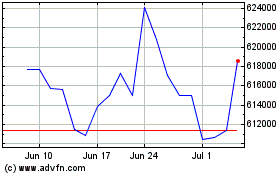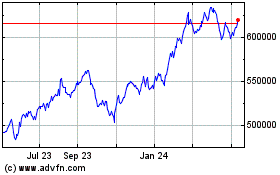New-Car Dealers Shine in Merger and Acquisitions This Year
December 21 2015 - 8:09PM
Dow Jones News
By Jeff Bennett
U.S. car dealerships changed hands at an accelerated pace this
year boosted by robust new-car demand, strong dealer profits and an
increased focus on the business following Warren Buffett's purchase
of a Phoenix-based chain.
A total of 456 dealerships have been acquired thus far in 2015,
a 40% increase over the prior year, according to The Banks Report,
which tracks merger and acquisitions in car retailing. The gains
comes as industry analysts expect U.S. vehicle sales to reach 17.5
million this year and expand again next year.
The rosy outlook is a dramatic reversal from 2009, when
thousands of dealerships were forced to close as Chrysler LLC, now
owned by Fiat Chrysler Automobiles NV, and General Motors Co. filed
for bankruptcy protection. Sales of new vehicles fell to 10.4
million that year, and many dealers' survival was in question.
Total dealerships in the U.S. has increased modestly to about
18,000 since the financial crisis and steady volume gains have
stirred new interest in the business. "Warren Buffett and others
have come to see dealerships as stable, slow predictable growth,"
Banks Report founder Cliff Banks said in an interview.
About 10% of the acquisitions this year were generated by large
publicly-traded dealer groups, such as AutoNation Inc. The Fort
Lauderdale, Fla.-based retailer bought more than 30 dealerships
expected to generate $1.7 billion in revenue. "We will continue to
seek acquisitions to leverage our scale," said Mike Jackson, chief
executive officer.
Still, there was plenty of opportunity for smaller players. Mark
McLarty, founder of McLarty Automotive Group in Little Rock,
acquired 15 stores this year bringing the total number of stores he
operates to 20. He has grown by snapping up stores from older
retailers who hung on through economic crisis are using the rebound
to call it quits while valuations are high.
"A lot of these guys who got through the recession now feel
their showroom values have recovered and now is the time to sell
rather than holding on and risk going through another downturn,"
Mr. McLarty said. "It's tough for the stand-alone, local
dealership."
The dealer said capital requirements continue to increase while
profit margins haven't expanded fast enough to keep up. "I think
you are only going to see more consolidation in the future," Mr.
McLarty said.
A trigger for the wider consolidation came in 2014, when Mr.
Buffett's Berkshire Hathaway Corp. bought 75 stores from
Arizona-based auto dealer Larry Van Tuyl.
Mr. Buffett said in March he would continue making such
acquisitions over the next couple of years.
U.S. new-car buyers are expected to spend $437 billion on
vehicles this year, a 7.3% increase over 2014.
Still, new-car price competition among dealers remains fierce
and auto manufacturers continue to demand hefty new
investments.
Mercedes-Benz USA, for example, is requiring its dealers to
invest about $200,000 to expand their showrooms and create a
special demonstration area if they want to sell the luxury auto
maker's AMG sports models next year. Those dealers who don't expand
risk falling to the end of the line when it comes to getting their
vehicle orders fulfilled.
Used-car sales and finance operations often offset weaker
profits in new-car departments and service bays, say industry
executives.
Despite such pressures, the value of the average dealership with
at least three stores increased 10% from 2014 to about $40 million,
according to Kerrigan Advisors, which helps dealers sell their
businesses. The typical new-car dealer owns three stores and the
real estate their franchises occupy.
Erin Kerrigan, founder of the Irvine, Calif.-based firm, expects
a new record for dealership mergers and acquisitions in 2016
because of the large number of dealership groups expected to go on
the block.
But she warns that "since car sales aren't going to grow much
more than where they are at today, there is little doubt in my mind
that we are at peak and many [dealership] sellers are choosing to
go to market."
Write to Jeff Bennett at jeff.bennett@wsj.com
(END) Dow Jones Newswires
December 21, 2015 19:54 ET (00:54 GMT)
Copyright (c) 2015 Dow Jones & Company, Inc.
Berkshire Hathaway (NYSE:BRK.A)
Historical Stock Chart
From Mar 2024 to Apr 2024

Berkshire Hathaway (NYSE:BRK.A)
Historical Stock Chart
From Apr 2023 to Apr 2024
